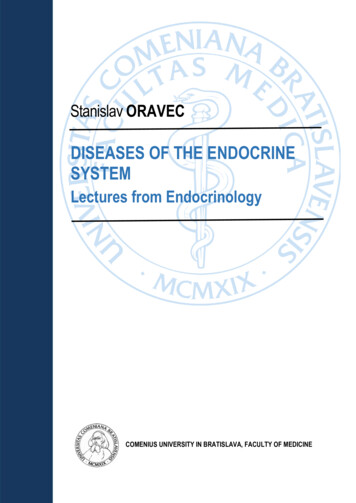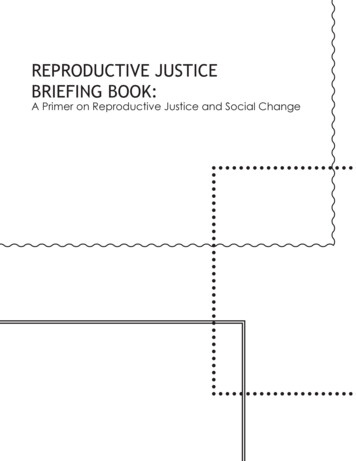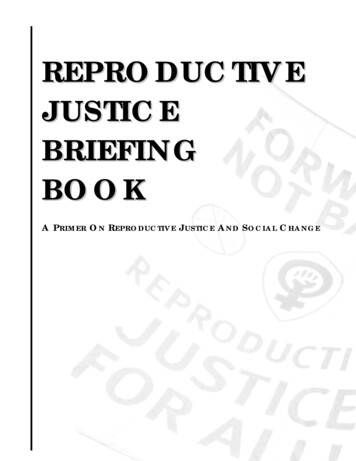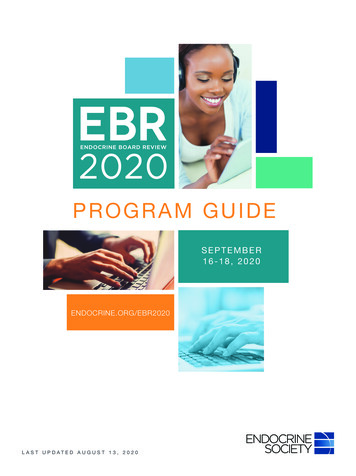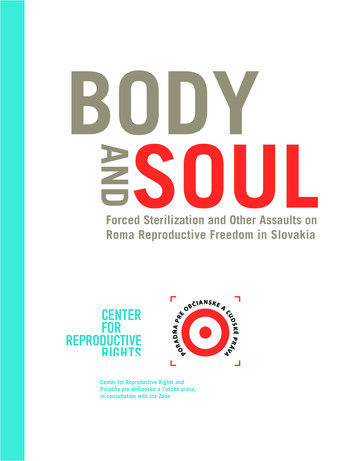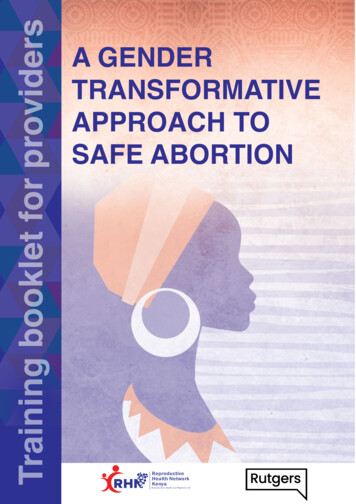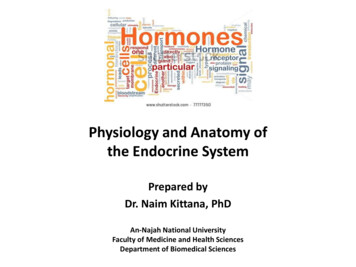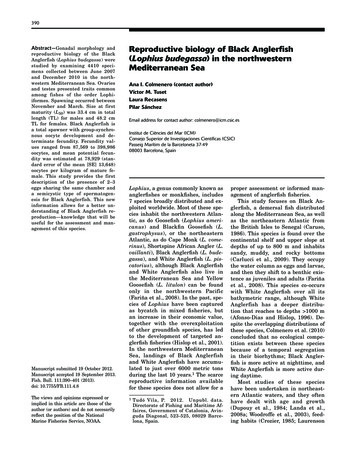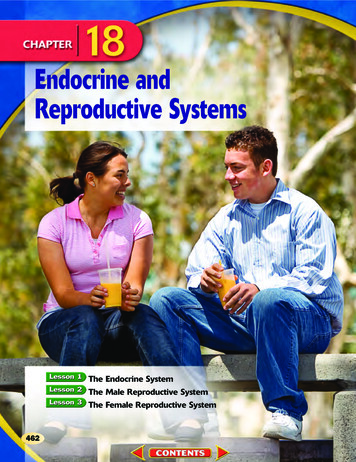
Transcription
Endocrine andReproductive Systems462Lesson 1The Endocrine SystemLesson 2The Male Reproductive SystemLesson 3The Female Reproductive System
GenderRepresentation inthe MediaIs there gender bias in news coverage? Are womenreporters seen as frequently on the news as men?Gender biases in the media may be reflected in television news reporting. magazine writing. newspaper writing.Visit the Eye on the Media section at health.glencoe.comto learn more about gender bias in your city’s media.Before You ReadStep 1Step 2Fold asheet ofpaperintothirds.Fold thebottomedge up 2inches andcrease.Make this Foldable to help you organizeyour notes on the structure and function ofthe endocrine system. Begin with a sheet of11” x 17” paper.As You ReadStep 3Endocrine SystemStructureFunctionProblemsGlue the outeredges of the foldto create threepockets. Label asshown. Place 3”x 5” notecardsor pieces of paperin the pockets.As you read and discuss the material in the chapter, usenotecards to record and define terms, draw diagrams, listmain ideas and supporting facts, and give examples of howyou might use what you’ve learned in your daily life. Placethe notecards in the appropriate pocket in your Foldable.Using Visuals. Many hormonal changes take place duringthe teen years. How are the endocrine and thereproductive systems related?463
LESSON1The Endocrine SystemGuide to ReadingFCAT LA.A.1.4.1, LA.B.1.4.2.Building VocabularyAs you read this lesson,write each new highlightedterm and its definition inyour notebook. endocrine glands (p. 464) hormones (p. 464) thyroid gland (p. 465) parathyroid glands (p. 465) pancreas (p. 465) pituitary gland (p. 465) gonads (p. 466) adrenal glands (p. 466)When the brain recognizesa stressful situation, theendocrine system reactsby releasing the hormoneadrenaline. How do thesechanges help prepare thebody to react under stress?Focusing on the Main IdeasIn this lesson, you will learnhow to: Describe the glands of theendocrine system and thefunction of each. Examine the effects of healthbehaviors on the endocrinesystem.Reading StrategyOrganize Information Make a two-column chart. Onthe left side of the chart, listfacts about the structure ofthe endocrine system,including the function of theglands. On the right side ofthe chart, list facts about theproblems of the endocrinesystem.The endocrine system causes bodies to change during adolescence.Write a short paragraph describing why it is especially important toeat nutritious foods during the teen years.All the cells in your body respond to messages sent by three of yourmajor body systems—the nervous system, the immune system,and the endocrine system. These three systems work closely togetherto coordinate the functions of the body. The endocrine system is especially important during the teen years because one of its main functions is to regulate growth and development. Health-literateindividuals can analyze and describe the relationship between theglands and hormones that control the secondary sex characteristics.Structure of the Endocrine SystemEndocrine glands are ductless—or tubeless—organs or groups ofcells that secrete hormones directly into the bloodstream. Hormonesare chemical substances that are produced in glands and help regulatemany of your body’s functions. Hormones are secreted by theendocrine glands and then carried to their destinations in the bodyby the blood. These chemical messengers influence physical andmental responses. Hormones produced during puberty trigger physical changes in the body. Figure 18.1 describes the major glands ofthe endocrine system and the body functions they regulate.464Chapter 18 Endocrine and Reproductive SystemsTake the Health Inventory for Chapter 18 at health.glencoe.com.
T HE E NDOCRINE S YSTEMThe glands of the endocrine system arelocated throughout the body. Each glandhas at least one particular function.Thyroid The thyroid gland produceshormones that regulate metabolism,body heat, and bone growth. Thethyroid produces thyroxine, whichregulates the way cells releaseenergy from nutrients.Parathyroid Glands The parathyroidglands produce a hormone thatregulates the body’s calcium andphosphorus balance.Testes The testes are the malereproductive glands.Ovaries The ovaries are the femalereproductive glands.Besides playing a role in reproduction (as described in Lessons 2and 3), the testes and ovaries controlthe development of secondary sexcharacteristics during puberty.Hypothalamus The hypothalamuslinks the endocrine system withthe nervous system and stimulates the pituitary gland tosecrete hormones.Pineal Gland This gland secretesmelatonin, which regulates sleepcycles and is thought to affectthe onset of puberty.Pituitary Gland The pituitaryregulates and controls activitiesof other endocrine glands.Thymus Gland The thymusregulates development of theimmune system.Adrenal Glands These glandsproduce hormones that regulatethe body’s salt and waterbalance. Secretions from theadrenal cortex and the adrenalmedulla control the body’semergency response.Pancreas The pancreas is agland that serves both thedigestive and the endocrinesystems. As an endocrine gland,the pancreas secretes two hormones that regulate the level ofglucose in the blood—glucagonand insulin.Pituitary GlandThe pituitary gland regulates and controls the activities of all of theother endocrine glands. The pituitary is known as the master gland. Ithas three sections, or lobes—anterior, intermediate, and posterior. Anterior lobe. The anterior, or front, lobe of the pituitarygland produces six hormones. Somatotropic, or growth, hormonestimulates normal body growth and development by alteringchemical activity in body cells. Thyroid-stimulating hormone(TSH) stimulates the thyroid gland to produce hormones.Adrenocorticotropic (uh-DREE-noh-kawr-ti-koh-TROH-pik)hormone (ACTH) stimulates production of hormones in theadrenal glands.Analyze What are thefunctions of the thyroid glandand the parathyroid gland(Figure 18.1)?Lesson 1 The Endocrine System465
Two hormones that stimulate production of all other sex hormonesare secreted by the pituitary’s anterior lobe during adolescence.Follicle-stimulating hormone (FSH) and luteinizing hormone (LH)control the growth, development, and functions of the gonads,another name for the ovaries and testes. In females FSH stimulates cells in the ovaries to produce estrogen, a female sex hormone that triggers the development ofova. LH is responsible for ovulation and stimulates ovariancells to produce progesterone. The hormone prolactin stimulates milk production in females who have given birth. In males LH stimulates cells in the testes to produce the malehormone testosterone. FSH controls the production of sperm.Hormones produced by thepituitary gland play a rolein determining height.Appraise the significanceof other body changesoccurring duringadolescence. Intermediate lobe. The intermediate, or middle, lobe of thepituitary secretes melanocyte-stimulating hormone (MSH), whichcontrols the darkening of the skin by stimulating skin pigments. Posterior lobe. The posterior, or rear, lobe of the pituitarygland secretes antidiuretic hormone (ADH), which regulatesthe balance of water in the body. ADH also produces oxytocin,which stimulates uterine contractions during the birth of a baby.Adrenal GlandsThe adrenal glands are glands that help the body recover fromstress and respond to emergencies. They each have two parts. The adrenal cortex secretes a hormone that inhibits theamount of sodium excreted in urine and serves to maintainblood volume and pressure. It also secretes hormones that aidthe metabolism of fats, proteins, and carbohydrates. These hormones play a role in immunity and the body’s response to stress. The adrenal medulla is controlled by the hypothalamus andthe autonomic nervous system. It secretes the hormones epinephrine (also called adrenaline) and norepinephrine. Epinephrineincreases heartbeat and respiration, raises blood pressure, andsuppresses the digestive process during periods of high emotion.Problems of the Endocrine SystemApply How can you keepyour endocrine systemfunctioning at peakperformance?466Factors such as stress, infection, and changes in the balance offluid and minerals in the blood can cause hormone levels tovary. Often these situations will correct themselves. More seriousproblems, including those described here, may require medication. Diabetes mellitus is a disorder in which the pancreasproduces too little or no insulin, resulting in high bloodglucose levels. Symptoms include fatigue, weight loss, thirst,and frequent urination.Chapter 18 Endocrine and Reproductive Systems
Graves’ disease, also called hyperthyroidism, is a disorder inwhich an overactive and enlarged thyroid gland producesexcessive amounts of thyroxine. Symptoms include nervousness, weight loss, increased thirst, rapid heartbeat, and intolerance for heat. Low thyroxine production, called hypothyroidism,causes fatigue, dry skin, weight gain, constipation, andsensitivity to cold. Cushing’s disease results from the overproduction of adrenalhormones. Symptoms include round face, humped upper back,thin and easily bruised skin, and fragile bones. Goiter, an enlargement of the thyroid gland, is caused mainlyby a lack of iodine in the diet. Since the introduction ofiodized salt, goiters have become rare in the United States. Growth disorders are caused by abnormal amounts ofgrowth hormone. With early diagnosis and proper treatment,a child with a growth disorder can reach a normal height.Staying physically active isone way to reduce stressand to keep your endocrinesystem healthy. Whatother healthful behaviorshelp ensure the health ofthis system?Care of the Endocrine SystemTo keep your endocrine system functioning at peak performance,take care of all of your body systems. Eat nutritious meals, getenough sleep, and avoid stress. A health care professional can perform medical tests to determine whether your endocrine functionis normal.LESSON1REVIEWFCAT LA.A.1.4.3, LA.E.2.2.1.Reviewing Facts and Vocabulary1. What is an endocrine gland?2. What are the two parts of the adrenal glands,and what do they do?3. What are the functions of FSH and LH?Thinking Critically4. Evaluating. Do you agree with the statement thatthe pituitary gland is the “master gland”? Explainyour reasoning.5. Analyzing. Which endocrine glands become moreactive during puberty? Name the hormones theseglands produce, and appraise the significanceof changes occurring during adolescence thatthey cause.Visit health.glencoe.com for the Interactive Study Guide for Lesson 1.Applying Health SkillsSelf Management. On a sheet of paper,write the names of two endocrine glands.List one important function of each gland.Then write a statement examining theeffects of health behaviors on theendocrine system.After You ReadCause and Effect. Create a two-columnchart. In one column, list the problemsthat may affect the endocrine system. Inthe second column, list some of thesymptoms of that disorder.Lesson 1 The Endocrine System467
LESSON2The Male Reproductive SystemGuide to ReadingFCAT LA.A.1.4.1, LA.B.1.4.2.Building VocabularyAs you read this lesson,write each new highlightedterm and its definition inyour notebook. reproductive system (p. 468) sperm (p. 468) testosterone (p. 469) testes (p. 469) scrotum (p. 469) penis (p. 469) semen (p. 469) sterility (p. 472)Focusing on the Main IdeasIn this lesson, you will learnhow to: Describe the parts andfunctions of the malereproductive system. Examine care of the malereproductive system andidentify situations requiringprofessional health services. Describe abstinence as itrelates to the prevention ofSTDs.Reading StrategyOrganize Information Create a chart with fourboxes. In the top left box, listthe functions of the malereproduction system. In thetop right box, list thestructure of the system. In thelower boxes, list ways to carefor the system on the left andproblems of the system onthe right.Write a short paragraphexplaining what changes occurwhen the male reproductivesystem matures.An essential function of all living things is reproduction, theprocess by which life continues from one generation to thenext. In humans, as in many other animal species, reproductionresults from the union of two specialized sex cells—one from themale and one from the female. These cells are made by the reproductive system, the system of organs involved in producing offspring.There are 300 million to400 million sperm in eachejaculation, but only onecan fertilize an ovum.What is the relationshipof testosterone to sperm?468Structure and Function of the MaleReproductive SystemThe male reproductive system includes both external and internal organs. The two main functions of the male reproductivesystem are the production and storage of sperm, the male reproductive cells, and the transfer of sperm to the female’s bodyduring sexual intercourse. During the early teen years, usuallyChapter 18 Endocrine and Reproductive Systems
between the ages of 12 and 15, the male reproductive systemreaches maturity. At that time hormones produced in the pituitarygland stimulate the production of testosterone , the male sex hormone. Testosterone initiates physical changes that signal maturity,including broadening of the shoulders, development of musclesand facial and other body hair, and deepening of the voice.Testosterone also controls the production of sperm. A physicallymature male is capable of producing sperm for the rest of his life.Health-literate teens can describe gender differences, expectations, and biases. At this time in a teen’s life, it is importantto learn to identify ways of resisting persuasive tacticsregarding sexual involvement.Development of facial hairis one of the changes thatoccur during a male’searly teens. Anotherchange is the ability toproduce sperm. Whichhormone stimulatesphysical changes in amaturing male?External Male Reproductive OrgansThe testes, the penis, and the scrotum areexternal structures involved in the process ofreproduction. The testes (singular, testis), alsocalled testicles, are two small glands that producesperm. These glands secrete testosterone. Thetestes are located in the scrotum, an external skinsac. The penis is a tube-shaped organ that extendsfrom the trunk of the body just above the testes. It iscomposed of spongy tissue that contains manyblood vessels. When blood flow to the penisincreases, it becomes enlarged and erect. Thisnormal body function is called an erection. Males experience erections easily and frequently during puberty. Erections can occur forno reason. Sometimes an erection results when clothing the maleis wearing causes friction.The penis releases semen. Semen is a thick fluid containing spermand other secretions from the male reproductive system. At the height ofsexual arousal, a series of muscular contractions known as ejaculation may occur. Fertilization—the joining of a male sperm celland a female egg cell—can result if ejaculation occurs during sexualintercourse.Sperm cannot live in temperatures higher than the normal bodytemperature of 98.6 F. The scrotum protects sperm by keeping thetestes slightly below the normal body temperature. When bodytemperature rises, muscles attached to the scrotum relax, causingthe testes to lower away from the body. If body temperature lowers,the muscles tighten and the testes move closer to the body forwarmth. Tight clothing that holds the testes too close to the bodymay interfere with sperm production.When a male begins to produce sperm, he may experience nocturnal emissions, or ejaculations that occur when sperm is releasedduring sleep. This is a normal function that relieves the buildup ofpressure as sperm begin to be produced during puberty.During puberty, teens should assess their lifelong health andother goals, and set personal goals for maintaining a healthy body.Cause and Effect Whatphysical changes are theresult of the male sexhormone testosterone?Responsibility. Here are someways a teen can show that he orshe is mature and responsible. Demonstrate respect foryourself and others. Control sexual urges, and neverimpose them on others. Practice abstinence from sexualactivity before marriage.Lesson 2 The Male Reproductive System469
Internal Male Reproductive OrgansAlthough sperm are produced in the testes, which are suspendedoutside the body, they must travel through several structures insidethe body before they are released. These structures include the vasdeferens, the urethra, the seminal vesicles, the prostate gland, andCowper’s glands. Figure 18.2 shows the path taken by sperm cellsfrom the testes until they are released from the body.M ALE R EPRODUCTIVE S YSTEMThe internal structures of the male reproductive system play a rolein the delivery of sperm.bladderSeminal Vesicle Assperm move through thevas deferens, they arecombined with anourishing fluid producedby the seminal vesicles.vas deferensProstate Gland andCowper’s GlandsSecretions from theprostate gland andCowper’s glandscombine with thesperm-containingfluid to form semen.penisscrotumUrethra The urethra is thepassageway through which bothsemen and urine leave the male body.Vas Deferens The vas deferens aretubes that extend from eachepididymis to the urethra.470Chapter 18 Endocrine and Reproductive SystemsEpididymis The tubes in eachtestis join the epididymis, alarger coiled tube wheresperm mature and are stored.Testis Each testis is dividedinto tiny tubules in whichsperm are formed.
FCAT LA.B.2.4.1.Monthly TSE Reminder CardIt’s important for males to do a testicularself-exam (TSE) every month. However, not allmales are accustomed to performing it. In thisactivity you will create a reminder card foryourself or the males in your family.What You’ll Need papercolored penslamination supplies (optional)What You’ll Do1. Cut the paper into a wallet-sized card.2. On one side of the card, write outthe steps in performing a TSE(see page 472).3. On the other side of the card, createa message that will remind andpersuade you or males in your familyto do a monthly exam. The exam couldbe scheduled for the same time eachmonth, such as the first day ofevery month.4. Laminate the card so that it will last.Apply and ConcludeKeep the reminder card in a locationwhere you (or males in your family) will seeit often. Because the best time to examineyourself is after a warm bath or shower,consider placing the card in the bathroom.Explain the importance of taking responsibility for regularly performing a TSE.Care of the Male Reproductive SystemCaring for the male reproductive system involves medicalcheckups, hygiene, protection, and self-examination. Ahealth-literate individual knows strategies for health enhancementand risk reduction. Get regular checkups. Have regular checkups by a physicianevery 12 to 18 months. Bathe regularly. Bathe daily, thoroughly cleansing the penisand scrotum. Wear protective equipment. Use a protective cup or supporter during physical activities to shield external organs. Perform regular self-examinations. Check the scrotum andtesticles for signs of cancer. Report any change to a physician. Practice abstinence. Abstain from sexual activity beforemarriage to avoid contracting STDs.Classify What are some ofthe STDs that affect the malereproductive system?Lesson 2 The Male Reproductive System471
Sexually Transmitted Diseases (STDs)Steps for Performinga Testicular ExamThe primary means of transmission of all STDs is sexual activity.An individual who practices abstinence before marriage understands the role of individual responsibility regarding personal riskbehaviors and how abstinence from sexual activity prevents STDs.One of the important benefits of abstinence is the prevention ofthese STDs: Chlamydia and gonorrhea are bacterial infections that causedischarge from the penis and burning upon urination; bothconditions can damage reproductive health. Treatment includesa course of antibiotics. Syphilis is another bacterial infection. Initially, a painless,reddish sore appears at the site of infection. If left untreated,syphilis can spread and damage internal organs. It is treatedwith antibiotics. Genital herpes is a virus that causes blisterlike sores in thegenital area. Medication relieves symptoms, but the virusremains in the body for life.The American Cancer Societyrecommends that males performa self-exam for testicular canceronce a month.Follow this procedure: Stand in front of a mirror.Check for any swelling on thescrotum skin. Examine eachtesticle with both hands. Rollthe testicle gently between thethumbs and fingers.Find the epididymis, the soft,tubelike structure behind thetesticle that collects and carriessperm. Become familiar withthis structure so that youwon’t mistake it for a lump.Cancerous lumps usually arefound on the sides of thetesticle but can also appearon the front.Although lumps do not alwaysindicate the presence ofcancer, be sure to consult ahealth care professional ifyou do find a lump.Source: American Cancer SocietyProblems of the MaleReproductive SystemThe organs of the male reproductive system can be affected byfunctional and structural problems, as well as STDs. These situations require professional health services.Inguinal HerniaAn inguinal (IN-gwuh-nuhl) hernia is a separation of tissue thatallows part of the intestine to push into the abdominal wall nearthe top of the scrotum. Straining the abdominal muscles or liftingheavy objects can cause a tear in this tissue. Symptoms of inguinalhernia may include a lump in the groin near the thigh, pain in thegroin, or in severe cases, partial or complete blockage of the intestine.Surgery is usually necessary to repair the opening in the muscle wall.SterilitySterility is the inability to reproduce. In males it can result fromtoo few sperm or sperm of poor quality. Sterility can result fromenvironmental hazards, including exposure to X rays and otherradiation, toxic chemicals, and lead. Hormonal imbalance, certainmedications, and use of drugs, including anabolic steroids, candamage sperm. Some diseases, including STDs, and mumps contracted as an adult also can result in sterility.472Chapter 18 Endocrine and Reproductive Systems
Testicular Cancer and Problems of the ProstateTesticular cancer can affect males of any age but occurs mostoften in males between the ages of 14 and 40. These factors increasethe risk of developing the disease: undescended testicle, abnormaltesticular development, and family history of testicular cancer. Amonthly testicular self-exam is recommended by the AmericanCancer Society. Males should be prompted to seek health careif they notice any warning signs, such as a painless lump orswelling in either testicle or pain or discomfort in a testicleor in the scrotum. With early detection most testicularcancer is treatable through surgery, radiation therapy, orchemotherapy.The prostate gland can become enlarged as a resultof an infection, a tumor, and age-related problems.An enlarged gland presses against the urethra, resulting in frequent or difficult urination. Symptoms mayalso indicate more serious conditions, includingprostate cancer. Prostate cancer screening is usuallydone during routine physical exams for males overage 50. Early detection increases the chance ofsurvival. Treatment includes surgery, radiation, andhormone therapy.LESSON2National and worldchampion cyclist LanceArmstrong is a survivorof testicular cancer.Why are testicularself-exams importantfor male reproductivehealth?REVIEWFCAT LA.A.1.4.3, LA.A.1.4.4, LA.B.1.4.2.Reviewing Facts and Vocabulary1. What is the function of the testes?2. Describe the path that sperm follow from the timethey form until they leave the body.3. What are the symptoms of testicular cancer?Identify situations requiring professional healthservices for preventive care.Thinking Critically4. Analyzing. Why would knowing the correct way tolift a heavy object be an important behavior toprotect the health of the male reproductive system?5. Synthesizing. Analyze the importance and benefitsof abstinence as it relates to the prevention ofSTDs. How can problems related to STDs affect themale reproductive system?Visit health.glencoe.com for the Interactive Study Guide for Lesson 2.Applying Health SkillsPracticing Healthful Behaviors. Analyzethe relationship between unsafe behaviorsrelated to drug use and the harmfuleffects of these substances on the malereproductive system. Write a paragraphstating how avoiding drugs, includingsteroids, can ensure the health of yourreproductive system.After You ReadIdentify Problems and Solutions. List atleast three problems that may affect themale reproductive system. After eachproblem, list some of the symptoms.Lesson 2 The Male Reproductive System473
LESSON3The Female Reproductive SystemGuide to ReadingFCAT LA.A.1.4.3, LA.B.1.4.2.Building VocabularyAs you read this lesson,write each new highlightedterm and its definition inyour notebook. ova (p. 474) uterus (p. 474) ovaries (p. 474) ovulation (p. 474) fallopian tube (p. 475) vagina (p. 475) cervix (p. 476) menstruation (p. 476)Focusing on the Main IdeasIn this lesson, you will learnhow to: Describe the parts andfunctions of the femalereproductive system. Examine the care of thefemale reproduction systemand identify situationsrequiring professional healthservices. Explain the importance ofabstinence as it relates to theprevention of STDs.Reading StrategyOrganize InformationMake a three-column chart.In the first column, list factsabout the structure andfunction of the female reproductive system. In the secondcolumn, list facts about thecare of the system. In thethird column, list facts aboutthe problems of the system. Write a short paragraphexplaining how the endocrineand reproductive systemsrelate to one another.The female reproductive system has several functions. It producesfemale sex hormones and stores female reproductive cells, calledOva (singular, ovum). The uterus , a hollow, muscular, pear-shapedorgan inside a female’s body, nourishes and protects thefertilized ovum from conception until birth.The female reproductivesystem stores ova thatunite with sperm in theprocess of reproduction.Name another function ofthe female reproductivesystem.474Structure and Function of the FemaleReproductive SystemThe female reproductive system includes several organs andglands. Ovaries are the female sex glands that store the ova andproduce female sex hormones. At birth a female’s ovaries contain morethan 400,000 immature ova, or eggs. One ovum matures eachmonth, beginning at puberty when the pituitary gland produceshormones. Ovulation is the process of releasing a mature ovum intothe fallopian tube each month. The right ovary will release a matureovum one month, and the left ovary will release one the next month.Chapter 18 Endocrine and Reproductive Systems
Female Reproductive OrgansFigure 18.3 shows the structures of the female reproductive system. Notice the tube that lies next to each ovary. When a matureovum is released from the ovary, it moves to one of the fallopiantubes , a pair of tubes with fingerlike projections that draw in the ovum.Tiny hairlike structures called cilia work, along with muscularcontractions in the fallopian tubes, to move the ovum along.Sperm from the male enter the female reproductive system throughthe vagina, a muscular, elastic passageway that extends from theuterus to the outside of the body.If sperm are present in the fallopian tubes, a sperm cell may unitewith an ovum, resulting in fertilization. The fertilization of an eggby a sperm produces a cell called a zygote. When the zygote leavesthe fallopian tube, it enters the uterus. There, the zygote attachesitself to the uterine wall and begins to grow. In preparation forreceiving the zygote, the uterine wall has thickened and is rich inblood, which enables the uterus to nourish the zygote. The developing fetus will remain attached to the uterine wall until birth.F EMALE R EPRODUCTIVE S YSTEMThe female reproductive system produces sex cells calledova and provides a place for a fertilized ovum to grow.Ovaries The ovaries contain ova and producehormones.Cervix The cervix is the opening of the uterus.Uterus The uterus protects and nourishesa developing fetus.Fallopian Tubes Ova, or eggs, travel from theovaries to the uterus through the fallopian tubes.Endometrium Endometrium tissue linesthe uterus.Maturing ovumMature ovumBladderUrethraVaginaLabia minoraLabia majoraLesson 3 The Female Reproductive System475
T HE M ENSTRUALCYCLEDays 1–13Day 14Days 15–20Days 21–28A new egg is maturinginside the ovary.The mature egg isreleased into one of thefallopian tubes.The egg travelsthrough the fallopiantube to the uterus.After seven days, if theegg is not fertilized,menstruation begins.MenstruationEating nutritious foodsand avoiding caffeine canoften reduce discomfortrelated to menstruation.What other healthbehaviors will keep yourreproductive systemhealthy?In a mature female, each month the uterus prepares for possiblepregnancy. If pregnancy doesn’t occur, the thickened lining of theuterus, called the endometrium, isn’t needed, and it breaks down intoblood, tissue, and fluids. These materials pass through the cervix,the opening to the uterus, and into the vagina. This shedding of the uterine lining is called menstruation and is part of the menstrualcycle, which is summarized in Figure 18.4. Females wear eithersanitary pads or tampons to absorb the blood flow. After the menstrual period ends, usually within five to seven days, the entire cyclebegins again in preparation for receiving a fertilized ovum the nextmonth.Most females begin their first menstrual cycle between the ages of10 and 15. The cycle may be irregular at first. As a female grows andmatures, her menstrual cycle usually becomes more predictable.Endocrine hormones control the cycle, but poor nutrition, stress,and illness can influence
Take the Health Inventory for Chapter 18 at health.glencoe.com. The Endocrine System FCAT LA.A.1.4.1, LA.B.1.4.2. All the cells in your body respond to messages sent by three of your major body systems—the nervous system, the immune system, and the endocrine system. These three systems work closely together to coordinate the functions of the .
